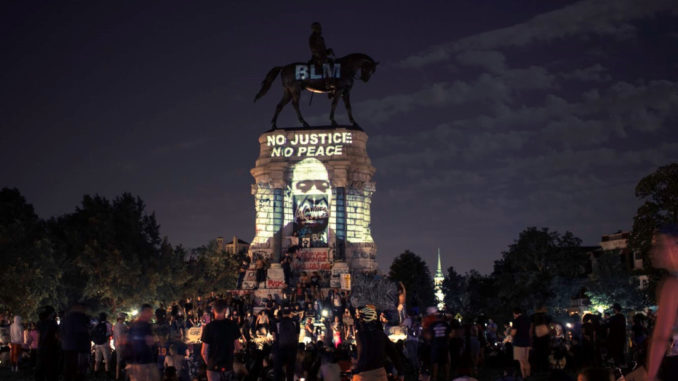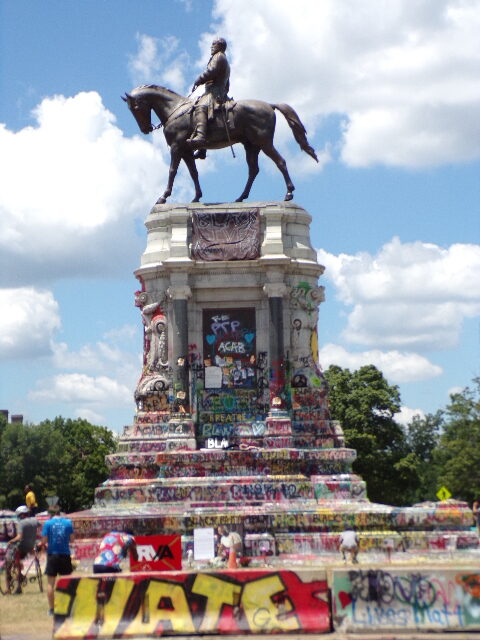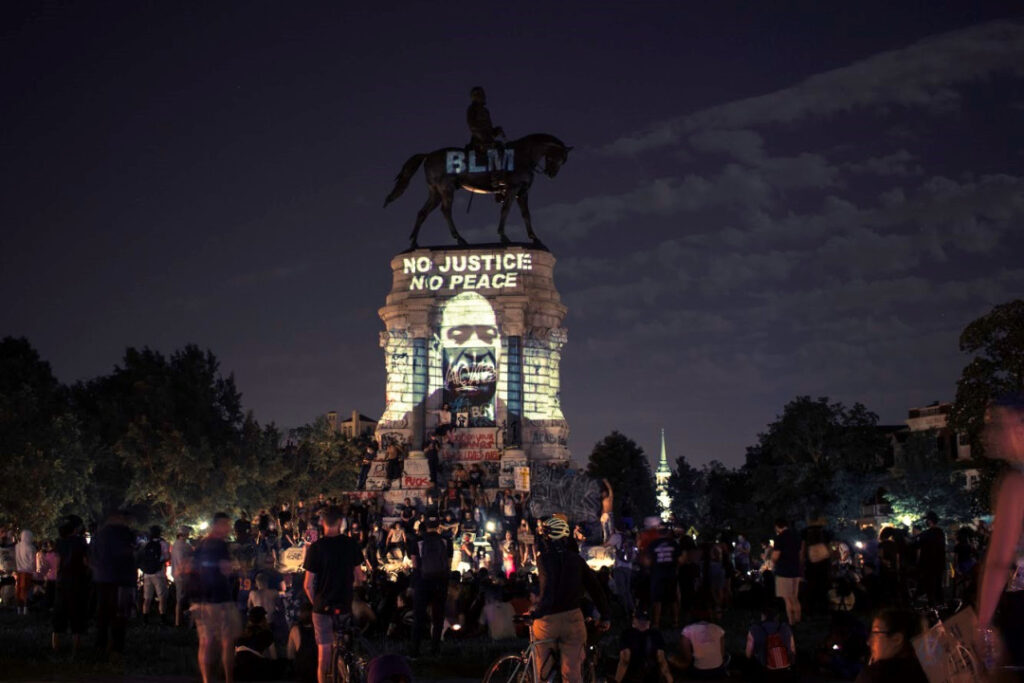
RICHMOND, Virginia—A large crowd gathered in a heavy downpour to watch history being made: The removal of the monument celebrating Confederate Gen. Stonewall Jackson.
Church bells rang in the distance as work crews took power tools to the feet of the statue. Once removed, the monument was placed on a flatbed and taken to an undisclosed location, its final fate undecided.

What happens to these monuments has created as much debate as the statues themselves. Some see the statues as representing history and want the monuments to at least be preserved, if they are removed.
Giving them to a museum is one popular choice. Linda St. Thomas, a spokeswoman for the Smithsonian said that they have not been offered any statues. “The National Museum of American History did say in 2017 that it would not be collecting memorials and monuments figures,” said St. Thomas. It is unlikely other prominent museums will instead. Confederate cemeteries are other popular choices.
Others see the monuments as symbols of bigotry and repression and want them destroyed. The Robert E. Lee monument in Richmond has been a focus of protests in the wake of the death of George Floyd, a Minneapolis man who died while in police custody.
“The SPLC does not support erasing history, nor the defacing and/or destruction of any historic artifact, but does believe that all Confederate symbols should be placed in their proper historical context,” said Lecia Brooks of the Southern Poverty Law Center to Zenger News.

The location and ownership of the monuments has a lot to do with what happens to them. The Stonewall Jackson statue was located on city property, giving Richmond Mayor Levar Stoney the right to tear it down.
Stoney cited public safety as the reason for the statue’s swift removal last week. “Failing to remove the statues now poses a severe, immediate and growing threat to public safety… As the COVID-19 pandemic continues to surge, and protesters attempt to take down Confederate statues themselves, or confront others who are doing so, the risk grows for serious illness, injury, or death.”
Statues have become a flashpoint for debate about race, and Confederate monuments aren’t the only ones under scrutiny. In Baltimore, protesters tore down a statue of Christopher Columbus, the 15th-century explorer some argue was a violent colonizer, and threw it in the city’s harbor Saturday.
The American Museum of Natural History in New York City has said it will remove a controversial statue of President Theodore Roosevelt, where he is depicted on horseback as a Native American man and a black man stand alongside. Protesters have also called for the removal of a statue of President Abraham Lincoln in Washington, D.C., that shows him standing over a kneeling African American man. That statue was paid for by former slaves.
The Robert E. Lee monument in Richmond sits on state-owned land, which means Virginia would decide whether to remove it. Virginia Gov. Ralph Northam, a Democrat, announced the statue would be removed, but the process is on hold pending the outcome of a lawsuit.
Richmond Circuit Court Judge Bradley Cavedo stopped the removal because of a lawsuit filed by William C. Gregory, the great-grandson of one of the people who deeded the statue and land to the state. The deed was given on the condition that the statue would never be removed.
Many of the nation’s Confederate monuments were partially paid for by the United Daughters of the Confederacy, who want to take possession of a statue of a Confederate soldier they erected in 1906 in Loudoun County, Virginia. “A council meeting is scheduled for the evening of July 7; but it is pretty much a done deal,” said Stephen Price, attorney for the United Women of the Confederacy to Zenger News.
The organization, which is headquartered in Richmond and has chapters in 33 states and the District of Columbia, was started by a group of women who supported Confederate soldiers during the Civil War. After the war, they tended the graves of the fallen and worked to build monuments and other types of memorials.
The United Daughters of the Confederacy did not respond to Zenger News’ request for a comment. “They are laying low. I can tell you they are not happy with the situation,” said Price.
The group’s public website includes a statement from 2018 that addresses the monument controversy.
“The United Daughters of the Confederacy appreciates the feelings of citizens across the country currently being expressed concerning Confederate memorial statues and monuments that were erected by our members in decades past,” Nelma Crutcher, president general of the group, noted in the statement. “To some, these memorial statues and markers are viewed as divisive and thus unworthy of being allowed to remain in public places. To others, they simply represent a memorial to our forefathers who fought bravely during four years of war. ”
There are more than 1,800 Confederate memorials in the U.S. “These symbols include government buildings, confederate monuments and statues, plaques, schools, parks, counties, cities, military bases, streets and highways named after anyone associated with the Confederacy,” said Brooks. “The SPLC tracks symbols that celebrate the Confederacy on public land. The SPLC does not track symbols located in graveyards, battlefields, on private property or those erected in the spirit of reconciliation.”
According to the mayor’s office, the city of Richmond has 60 days to solicit pubic input while determining the fate of the statues.
The post UDC quietly offers to remove Confederate monument as protesters clamor for statues to fall appeared first on Zenger News.






